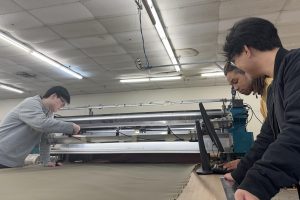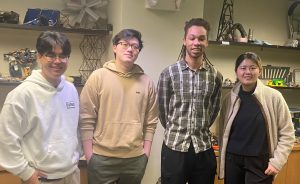
Blind Industries and Services of Maryland (BISM) is a leading provider of military uniforms, cutting and sewing thousands of garments each year for the Department of Defense and other federal agencies. To help ensure the quality of those uniforms, a team of Johns Hopkins mechanical engineering students has developed an autonomous, AI-powered system capable of detecting flaws in the fabric BISM employees use.
“BISM approached us to create an inspection system that would perform the quality control job of the sighted employee, thus freeing that employee up for other tasks,” said team member Jay Lawrence, who worked with Ray Chen, Harrison Le, and Amy Zhang on the project. The team will present its approach at the Whiting School of Engineering’s annual Design Day on May 1.
During a visit to BISM’s workroom in Baltimore County to observe the garment-production process, the team noted that a sighted employee typically inspects fabric as it is unrolled and before it is cut into pieces that are later sewn together by blind workers.
The students designed an image-capturing system that uses a machine-learning algorithm to recognize fabric defects and alert the blind operator to the defect with a sound as it is unrolled. The operator, once alerted, gets confirmation from a sighted inspector of the defect, backed up by a light on the device. The defective section is then cut out and the process starts over.
“There’s a spectrum of vision impairment among the workers at BISM but we’re designing for a user with no vision at all,” Chen said. “We met with actual users to get an idea of how they would interact with the system. This is not a community any of us were born into, so we’re entering that space respectfully.”
The mechanical aspect of the project was squarely in the students’ expertise but developing the interface required approaching the engineering from a different angle, the students said.

Team members, L to R: Harrison Le, Ray Chen, Jay Lawrence, Amy Zhang
“All of us are mechanical engineers; none of us are computer engineers,” Lawrence said. “So we had a lot of learn-as-we-go situations. In this project, we’re essentially employing machine learning or a neural network.”
Similar systems exist for inspecting materials like those used in automotive manufacturing, Chen said. But fabric can present a challenge as it’s so varied.
“This needs to be trained on fabrics that haven’t been seen by the system before, and there may even be defects that haven’t been seen before,” he said. “We want a system that’s robust.”
Juhi Narula, BISM’s youth transitions program manager, praised the team and their work: “It’s been an exciting opportunity for us to explore how we can make our manufacturing processes more accessible. The students have been great partners on this project.”
Anic Zlotescu, BISM’s training and accessibility manager, said the students’ design helps advance her organization’s mission.
“[The students’] work allows operators to work with increased agency and independence. That is the mission behind our operations,” she said.